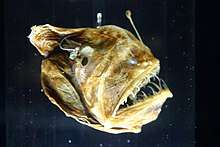Humpback anglerfish
| Humpback anglerfish | |
|---|---|
 | |
| Scientific classification | |
| Kingdom: | Animalia |
| Phylum: | Chordata |
| Class: | Actinopterygii |
| Order: | Lophiiformes |
| Family: | Melanocetidae |
| Genus: | Melanocetus |
| Species: | M. johnsonii |
| Binomial name | |
| Melanocetus johnsonii Günther, 1864 | |
Melanocetus johnsonii is a species of black seadevils in the family of Melanocetidae, which means “black large sea creature” in Greek.[1] It is named after James Yate Johnson after he discovered the fish in Madeira.[2] The common names include humpback anglerfish, humpback blackdevil, and Johnson’s anglerfish.[2][3]
Habitat

M. johnsonii lives in the mesopelagic and bathypelagic zones, which is 1,000 to 4,000 meters in depth.[4] There is no light penetrating from the surface photic zone. The only light that the deep sea organism could see is bioluminescence, which is the light produced by many marine organisms.[5] M. johnsonii lives in a fairly large range of depths, usually active from 100 to 1,500 meters in depths but also found at a depth of 4,500 meters.[1]
It was thought to be widely distributed in the temperate and tropical ranges of all oceans, as well as in South China Sea and East China Sea.[1] However, in recent study, the first specimen of M. johnsonii in Antarctic waters of the Ross Sea was obtained from the stomach of an Antarctic toothfish on Jan 6, 2014.[6] The specimen was identified by morphologic methods and further genetic analysis using the fish’s pectoral fin clipwhich verified that the specimen belonged to M. johnsonii.[6]
Morphology
M. johnsonii is a black soft-bodied anglerfish. It does not have scales or pelvic fins. Female humpback blackdevils have large heads with a widened mouth and long pointed teeth, capable of eating prey larger than themselves.[1][3] As similar to all other anglerfish, females have a short dorsal fin spine (illicium) with a bulbous luring apparatus (esca) on the snout.[3][7] The esca has compressed posterior and anterior crests, noted when distinguishing it from other anglerfish.[1][7]
Humpback anglerfish exhibits extreme sexual dimorphism, with larger size females and dwarfed males.[1] Females grow to 18 cm and males only grow to 2.9 cm.[1][3] Unlike M. murrayi, females have nearly a straightened anterior margin of vomer. Males usually have a relatively larger number of denticular teeth and dorsal and pectoral fin rays.[3] Also, as there are many similarities in morphological characteristics of M. johnsonii and M. rossi, one distinguishing feature is that M. johnsonii has black pigmentation on its upper body exterior while M. rossi does not.[6]
Feeding behavior
The predation strategy for M. johnsonii is to sit-and-wait like other Ambush predators. Females use the bulbous esca as a bioluminescent lure to attract prey as well as potential mates.[8] The bioluminescence of M. johnsonii is an example of bacteria living in symbiosis with the hook of the fish.[9] In the deep sea, there is not much of a food source as only 5% of nutrition produced by the photic zone in the open passes down to the deep ocean.[5] The large mouth, sharp teeth and big stomach with massive capacity help the females eat nearly everything they encounter.
Males are much smaller and are not predatory.[8] Records show that males have a much more developed sensory system to locate females.[4] However, since only eight male specimens were obtained up to date, information concerning males is limited.
Reproduction
Finding a mate for M. johnsonii is difficult as they are far apart from each other in the deep sea. Unlike in other species of anglerfish, males of M. johnsonii are non-parasitic.[4][8] They temporarily attach onto the larger female fish to release the sperm and release the females afterwards to find other mates.[4] Also, the reproduction of black anglerfish is carried out by external fertilization. Females release eggs into the water and males would then immediately exert their sperm to capture and fertilize the eggs.[7] This unique reproduction process might explain why males of M. johnsonii do not live on females for their entire life.
Conservation
M. johnsonii was classified as a “Least Concern” species on IUCN Red List of Threatened Species.[4] It is not a food source for humans and, therefore, is not hunted by humans. The small number of the population might be due to the scarcity of the species in the deep sea environment.[8]
References
| Wikimedia Commons has media related to Humpback anglerfish. |
- 1 2 3 4 5 6 7 Froese, R. and D. Pauly, Editors. Melanocetus johnsonii. FishBase. 2015.
- 1 2 Fitch, J.E. and R.J. Lavenberg, 1968. Deep-water teleostean fishes of California. California Natural History Guides:25. University of California Press, Berkeley and Los Angeles, California. 115 p.
- 1 2 3 4 5 Humpback Blackdevil, Melanocetus johnsonii Gunther, 1864. Australian Museum.
- 1 2 3 4 5 Arnold, R. 2015. Melanocetus johnsonii. The IUCN Red List of Threatened Species 2015: e.T18127840A21911455. https://dx.doi.org/10.2305/IUCN.UK.2015-4.RLTS.T18127840A21911455.en. Downloaded on 21 February 2018.
- 1 2 Paddy Ryan, 'Deep-sea creatures - The bathypelagic zone', Te Ara - the Encyclopedia of New Zealand, http://www.TeAra.govt.nz/en/deep-sea-creatures/page-3 (accessed 17 February 2018)
- 1 2 3 Orlov, A. M., et al. (2015). First record of humpback anglerfish (Melanocetus johnsonii) (Melanocetidae) in Antarctic waters. Polar Research, 34.
- 1 2 3 Quigley, Declan T, 2014. "Ceratioid Anglerfishes." Sherkin Comments. Issue No 58, 7.
- 1 2 3 4 Humpback anglerfish. Ocean Animal Encyclopedia. Oceana.
- ↑ Szakmány, Csaba. "Luminescence in Nature and in the Education." Physics Competitions (2013).
External links
- Melanocetus johnsonii. Marine Species Identification Portal.
- Melanocetus johnsonii specimen. Museum of New Zealand Te Papa Tongarewa.
